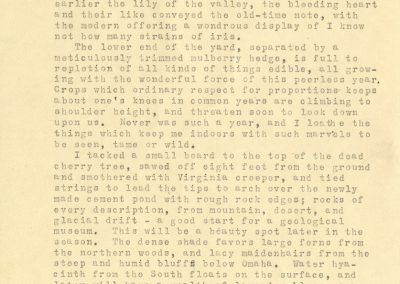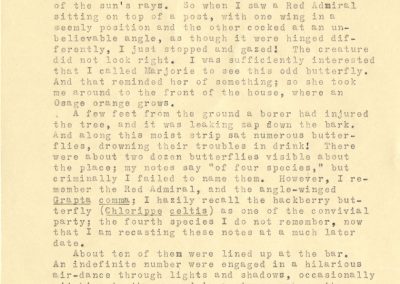Great Nebraska
Naturalists and ScientistsFrank H. Shoemaker
[Marjorie’s Garden] 1919, June 21
1
June 21, 1919
Lincoln, Nebraska
Today I visited the garden which Marjorie and her mother play with and love. Such a beauty it is, given the atmosphere of happy yesterdays by hollyhocks, larkspurs, Canterbury bells. A little earlier the lily of the valley, the bleeding hearts, and their like conveyed the old-time note, with the modern offering a wondrous display of I know not how many strains of iris.
The lower end of the yard, separated by a meticulously trimmed mulberry hedge, is full to repletion of all kinds of things edible, all growing with the wonderful force of this peerless year. Crops which ordinary respect for proportions keeps about one’s knees in common years are climbing to shoulder height, and threaten soon to look down upon us. Never was such a year, and I loathe the things which keep me indoors with such marvels to be seen, tame or wild.
I tacked a small board to the top of the dead cherry tree, sawed off eight feet from the ground and covered with Virginia creeper, and tied strings to lead the tips to arch over the newly made cement pond with rough rock edges; rocks of every description, from mountain, desert, and glacial drift – a good start for a geological museum. This will be a beauty spot later in the season. The dense shade favors large ferns from the northern woods, and lacy maidenhairs from the steep and humid bluffs below Omaha. Water hyacinth from the South floats on the surface, and later will have a wealth of lavender blossoms, borne aloft like banners. Goldfish and salamanders live peacefully in the depths.
But what I want to tell about is the disgraceful behavior of the butterflies. Fancy a butterfly behaving disgracefully! But there it is.
2
Every observer knows how unswervingly “bilateral dynmetry,” where it exists, holds away in every form. If a butterfly at rest spreads or raises its wings, the movement is symmetrical for both wings – unless the butterfly is tilting, like Gilbert White’s turtle, to catch the ultimate beat of the sun’s rays. So when I saw a Red Admiral sitting on top of a post, with one wing in a seemly position and the other cocked at an unbelievable angle, as though it were hinged differently, I just stopped and gazed! The creature did not look right. I was sufficiently interested that I called Marjorie to see this odd butterfly. And it reminded her of something; so she took me around to the front of the house, where an Osage orange grows.
A few feet from the ground a borer had injured the tree, and it was leaking sap down the bark. And along this moist strip sat numerous butterflies, drowning their troubles in drink! There were about two dozen butterflies visible about the place; my notes say “of four species,” but criminally I failed to name them. However, I remember the Red Admiral, and the angle-winged Grapta comma; I hazily recall the hackberry butterfly (Chlorippe celtis) as one of the convivial party; the fourth species I do not remember, now that I am recasting these notes at a much later date.
About ten of them were lined up at the bar. An indefinite number were engaged in a hilarious air-dance through lights and shadows, occasionally pitching to the ground in a stupor, where they might be approached and touched without their taking flight. The fliers were so reckless and woozy that some of them bumped into or alighted upon us. Several were sobering up on neighboring flowers or leaves, with wings tilted awry, like the inebriate which I had first noticed. And presumably a far
3
greater undiscoverable number were sleeping it off at home or in jail. – It was positively shocking; such a nice neighborhood and all!
Evidently, obviously, the sap of the Osage orange is intoxicating to butterflies. I had never before changed upon an orgy of this kind. But trust Marjorie to see whatever is natural-historically interesting is going on!


